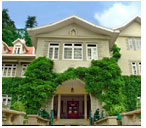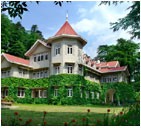
Woodville Palace has a history dating back to 1866 when Sir William Mansfield, Commander-in-Chief of the imperial army became the first resident of the charming estate.
The palace was reconstructed in 1938 by the Rana of Jubbal when hundreds of expert artisans were brought from far and wide to ensure the highest quality of craftsmanship.
Kanwar Udai Singh opened a part of the mansion as a guest house in 1977 and today, the palace is one of the finest places to stay in Shimla.
In 1926, His Highness Maharaja Sir Bhagvat Singh of Gondal State in Western Indian purchased the property for his daughter, Princess Leila. In 1938, the old Victorian building was demolished by her husband, Raja Rana Sir Bhagat Chand, the ruler of Jubbal State. In its place the present magnificient summer palace was constructed at a cost of Rupees Five Hundred Thousand.
The Jubbal royal family belong to the Rathore clan of Chandravanshi Rajputs who were renowned for their chivalry and bravery and can trace their origins upto 300 years. Raja Bhagat Chand was one of the most enlightened rulers amongst the Shimla Hill States, and represented the Shimla Hill States in the Council of Princes from 1921-1924. He was made a C.S.I. (Companion of the Star of India) in 1928 and a K.C.S.I. (Knight Commander of the Star of India) in 1936 for meritorious services.
His youngest son, late Lt. Col. Raj Kumar Birender Singh, was one of the earliest commissioned officers of the British Indian Army who fought for his country overseas during the World War II. It was his son, Kanwar Uday Singh, who coverted Woodville Palace into a heritage hotel in 1977. At present, the first floor of the hotel is occupied by his family while the rest of the building is open to visitors.
Woodville Palace Hotel
Raj Bhawan Road
Shimla
Himachal Pradesh
0177) 223919 / 224038
(0177) 223098
[email protected]
An IT professional for 17 years, based in the US since the last 12 years. Founded NGO My Himachal and then Himachal Media Pvt. Ltd.. A Himachali forever. Always trying to bring together people whose hearts beat for the state.





A historic view from the turrets of woodville
SHONA ADHIKARI traces the historical past of the palace which once was the official summer residence of the Commander-in-Chiefs of Imperial India.
This is a manor house with an interesting historical past. How the estate passed from British hands into that of the royal family of Gondal in Kathiawar, makes a good story – the sort of story that many of the old houses in India have, only it is not always possible to find out all the details. Fortunately in the case of Woodville, most of the historical facts are available. Located barely half a mile from the Mall, the main shopping centre for Shimla, the Woodville Palace was once the official summer residence of the Commander-in-Chiefs of India. It even looks the part with its gabled roofs and turrets, set amidst the lush green of four acres of deodar and pine.
Shimla the summer capital of the British still has much to offer that reflects its colonial past, and the Woodville estate as the property of General Sir William Rose Mansfield, Commander-in-Chief of Her Majesty’s Forces in India, is certainly one of these. According to an existing document, Sir William purchased the property from Major-General Arthur Milford Beecher on February 2, 1866 for a princely sum of Rs 22,000, and from then on Woodville became the official summer residence of the Commander-in-Chiefs of India. In 1876, General Mansfield sold Woodville to Mrs Henrietta Ruth Maria Alexander, who followed the tradition and leased out the property to the Commanders-in-Chief of India for the next six years.
Woodville passed through a number of hands till it was sold to the Alliance Bank of Simla for Rs 1,25,000, a very large sum those days. In 1922, the Alliance Bank moved its headquarters to Calcutta, leading to its collapse and closure in 1923.
Woodville was put on sale, as part of liquidation of the Bank’s assets. Wishing to purchase the property in 1926, Maharaja Sir Bhagvat Singh Sangram of Gondal, approached the bank’s liquidators.
Native princes had to seek special permission to acquire any property in British India. Fears that the lifestyle favoured by the Maharaja may be too exotic for the delicate sensibilities of the British residents, was probably the only reason for apprehensions about any objection. However there were no serious objections, except for the fact that Woodville was a rather desirable property, and was passing from British hands into those of a native prince.
Maharaja Bhavgat Singh purchased Woodville for Rs 120,000 and also paid another Rs 5000 for the furniture and fittings, keeping the property till 1931, when he gifted it to his daughter Maharaj Kumari Leila – who married Raja Rana Sir Bhagat Chand of Jubbal, one of the hill states in British India. Raja Bhagat Chand, found the old Victorian building lacking in many ways, and decided to tear down the structure in 1938 and build a new palatial building. The new Woodvilte Palace was designed by the Army and Navy Stores of London. To conserve the surrounding forest, Raja Bhagat Chand had all the deodar wood used for the building brought to Simla from Jubbal State – famous for its 288 square miles of dense forest. For creating the fashionable new ‘masonite flooring’, skilled Chinese carpenters were called from Bombay. The total expenditure for the new building was almost rupees five lakhs. Post independence, there were futile attempts made by the Punjab Government to take over the estate. In 1959 Rani Leila gifted the property to her two grandchildren, Rajkumar Udai Singh and his elder sister, Rajkumari Niera Devi.
As maintaining an estate was found to be rather an expensive proposition, Udai Singh and Niera Devi converted part of Woodville in 1977 into a guest house and thereafter into a heritage hotel. Keeping all the furniture and furnishings intact, Woodville Palace reflects the traditional art deco period of the 1930s and is maintained in much the way the Rana had intended it to be.
At Woodville Palace, there is a beautifully executed portrait of the Rana. The portrait hangs in The Hall, by the side of the wooden staircase, made out of the deodar trees from his erstwhile state of Jubbal. From his vantage position, perhaps he still guides the activity at Woodville.
TRAVEL TIPS
How to get there: There are daily flights between New Delhi and Shimla and the airport is just 20 km from Woodville Palace.
There are many trains from Delhi to Kalka Station, and from there the narrow-guage train can be taken for a very picturesque 6 hour journey up to Shimla. The Shimla Railway Station is 7 km from Woodville Palace.
The distance from Chandigarh to Shimla is 117 km. There are plenty of deluxe coaches available between Chandigarh and Shimla.
For further information contact: Welcome Heritage, C-7, 2nd Floor, J-Block Market, Saket, New Delhi – 110 017. Tel: (011) 6868992, 6868993, 6861875, 6850438.